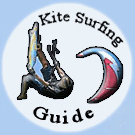Avoid Getting Lofted
One of the most dangerous situations while kitesurfing is to get lofted. Powerful wind may send a kitesurfer upward if his kite is packed overhead. That is because kitesurfing has high powert demands! Usually called tea bagging getting lofted in water can be a lot of fun, but that is not the case if you get lofted on land. A person can get badly injured or even die due to this kind of accident.
Rick Iossi has written some tips and advices on how to avoid these accidents:
Lofting is a reality for kiteboarders, fortunately for whatever reasons, a somewhat rare one though. This may be due to critical timing of the gusts, while being airborne off the water and more vulnerable to being moved along further and/or higher. Who really knows at this point. Several kiteboarders have been lofted while standing still, so being airborne isn’t strictly required, but it helps. I have put together a set of precautions that seem to make sense. Input is welcome, particularly from kiteboarders who have been lofted.
Gusts are the most common cause of course, more rare causes could include the apparent dust devil that occurred in Spain with Robert Sanchez's fatal accident and the thermal bubble that lofted Eric in Oahu to an incredible 225 ft.
- Pick your weather carefully. If the weather radar, wind plots imply squalls or unduly gusty weather or if obvious storm clouds or other signs of unstable weather are moving in, it would be a good idea not to go kiteboarding. When in doubt, don’t fly, wait for stable weather.
- If you are stationary in the water or on land, try to keep your kite at the edge of the wind window and near the surface. This may result in your being dragged as opposed to lofted, so plan accordingly. Be ready to depower your kite at the earliest opportunity if hit by a strong gust to try to avoid extended dragging and potential serious injury.
- If you are near hard objects or if pronounced gusty conditions are developing, stay unhooked and be prepared to let go or more ideally, use a snap shackle to secure your chicken loop. It is important that the snap shackle is rigged properly to improve reliability of release. If you do use a snap shackle, rehearse mentally, frequently, " if I get lofted, pull the snap shackle release cord". In the shock of lofting, your reactions may be slow, so rehearsing may help. Of course if you are already high over land, this one is a very tough judgment call as riding things out may be the wiser course. To avoid having to make such critical decisions in very little time, which may result in injury regardless of the decision, the best course is to work hard to avoid circumstances which may lead to lofting in the first place.
- Avoid or simply don’t fly with onshore winds or kiteboard within 300 ft. upwind of hard objects. If you go out in onshore winds, which is NOT RECOMMENDED, kiteboard more than 300 ft. offshore until it is time to come in. I would come in without delay, keeping the kite low and be prepared to let go of your bar if lofted. This technique generally requires assisted landings shortly after you make it to shore. Do not jump within 300 ft. of shore or hard downwind objects. If feasible it would be a good idea to have assisted launches and landings at least 200 feet offshore in onshore winds, thereby avoiding having an airborne kite closer to shore than 200 feet.
- Be particularly cautious while upwind of bystanders. If circumstances seem to support possible lofting, it would be best not to launch at all. If the rider decides to go despite this recommendation and prudence, he should move a substantial distance away from the bystanders.
- Try to use shorter line sets if you are expecting stronger winds. Also try not to fly a larger kite than supported by apparent conditions.
- Always wear a helmet! Wearing an impact vest is also a good idea.
- Do not come within 100' of substantial vertical surfaces or walls with onshore winds to avoid potentially being lifted. In theory even relatively minor winds could cause substantial uplift along the face of buildings, cliffs, etc.
- Do not fly your kite near thermal generating conditions.
|


